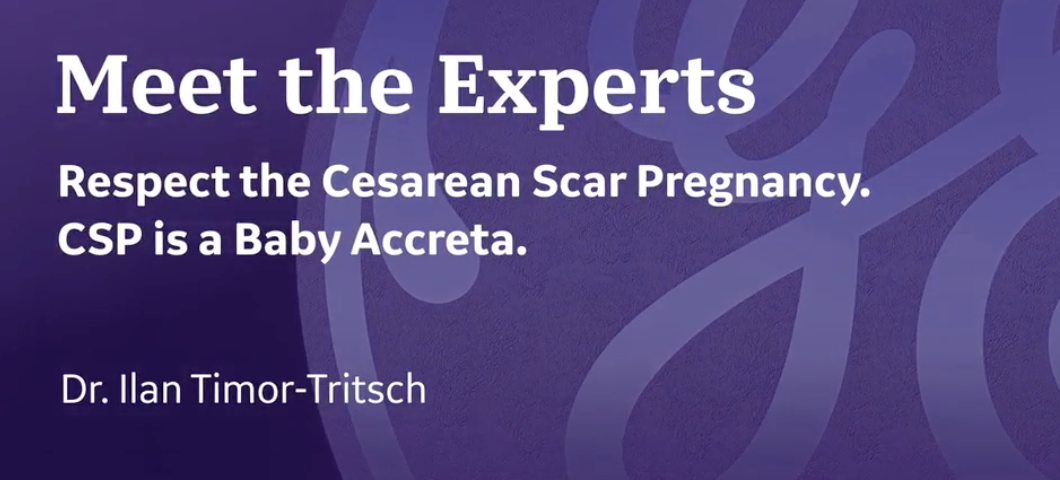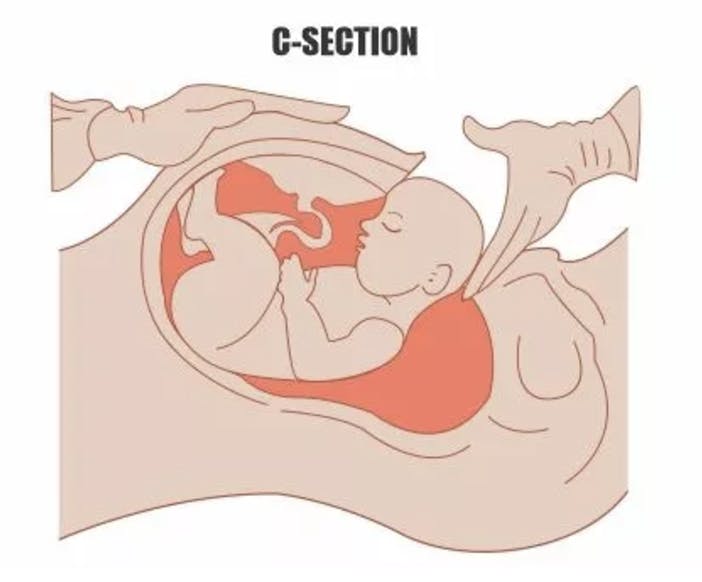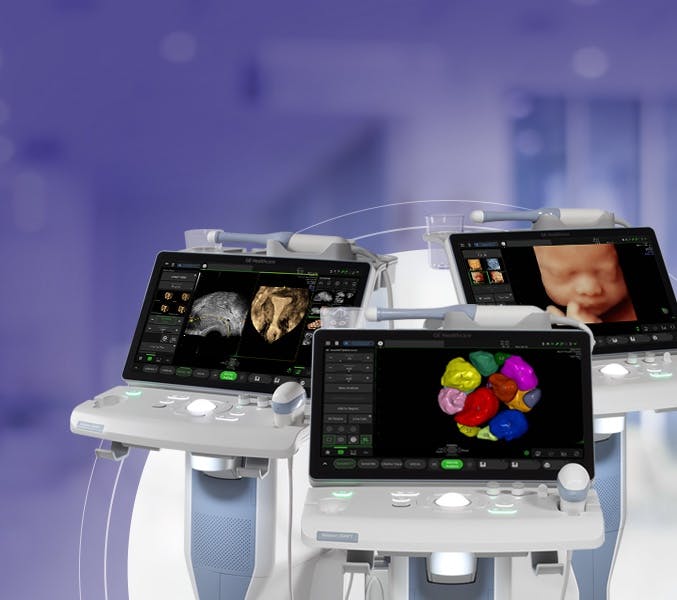Distinguished Professor of Obstetrics and Gynecology at the New York University School of Medicine, Dr. Ilan Timor-Tritsch, hosted a lecture with GE HealthCare to speak about the intricate relationship between Cesarean scar pregnancy (CSP) and placenta accreta spectrum (PAS). Timor-Tritsch, a renowned expert in ultrasound diagnostics, unfolds the nuances of CSP, exploring risk factors, pathogenesis, pregnancy complications, and the profound implications these pregnancies may have on maternal health.
Full video 'Respect the caesarean scar pregnancy - CSP is a Baby Accreta' can be seen HERE.

Exploring the Links Between CSP and PAS
Timor-Tritsch begins by acknowledging the surge in Cesarean deliveries over the past four decades and how this increase has paralleled a rise in cases of placenta accreta and percreta. However, he accentuates a critical connection that has been somewhat overlooked: the correlation between CSP and the consequences that unfold in the second and third trimesters, encapsulated in the broader spectrum of placenta accreta.
Scar pregnancies, as Timor-Tritsch explains, pose a potential threat stemming from previous Cesarean deliveries. Pregnancies implant on the Cesarean scar in two distinct types: type 1 implants on the scar, and type 2 implants in the niche. Contrary to misconceptions, scar pregnancies are not ectopic. Instead, they can result in live-born babies, making early recognition and proper management paramount to avoiding pregnancy complications throughout all trimesters.
Previous myomectomies, too, pose a significant risk, and the rate of CSP is around 1/2000. The increasing incidence of this condition likely stems from greater awareness and more accurate diagnosis since the rates of Cesareans have stabilized in recent years.
Ultrasound Markers for Identifying CSP
Ultrasound emerges as a crucial diagnostic tool in identifying Cesarean scar pregnancies. Timor-Tritsch meticulously details the ultrasound markers to identify these pregnancies, which include:
- Low anterior gestational sac within the uterine cavity
- Placenta previa with lacunae
- Thin or absent myometrium between the placenta and bladder
- Irregular bladder lines
- Increased vascularity at the bladder-placenta interface
These diagnostic markers are key indicators for timely diagnosis, a pivotal factor in effective management.
Timor-Tritsch reviews the most important early ultrasound findings and techniques for identifying scar pregnancies. After seven weeks, these findings change as the pregnancy grows, highlighting the importance of early transvaginal ultrasound to determine pregnancy location and relationship to the Cesarean scar.
The Pathogenesis of CSP
Timor-Tritsch explains that Cesarean scar pregnancy is a secondary defect of the endometrial interface, resulting in abnormal trophoblast implantation and infiltration. Importantly, vascular changes associated with deep placentation commence as early as the first trimester. This sets the stage for the central theme of Timor-Tritsch's presentation: the intricate connection between Cesarean scar pregnancy and placenta accreta spectrum.
First-Trimester Ultrasound Diagnosis of CSP
Timor-Tritsch explains that the first trimester provides a window into the evolving scenario. He introduces the concept that Cesarean scar pregnancy is essentially a precursor to placenta accreta spectrum, which clinicians might identify as soon as the first trimester. He highlights the contributions of Drs. Comstock and Jauniaux, two thought leaders in this area.
Through ultrasound markers, especially before the 11th week, he draws attention to the similarities between the diagnostic signs of Cesarean scar pregnancy and those that manifest later in the placenta accreta spectrum. Of note, Timor-Tritsch highlights the use of the SlowflowHD microvascular color Doppler to image the early placental invasion of a scar pregnancy into the myometrium as early as six weeks gestation.
Timor-Tritsch reviews outcome data from a study by Dr. Cali. These findings reveal that expectant management of these pregnancies may be associated with severe bleeding and other pregnancy-related complications, especially for pregnancies with cardiac activity. Healthcare providers should manage these pregnancies in specialized centers.
Two-thirds of these continue as PAS pregnancies. Timor-Tritsch contends that integrating first-trimester assessment into ultrasound staging of PAS is not only feasible but serves as a predictive measure for surgical outcomes. His work has shown that CSP and PAS are histologically identical diseases.
Second-Trimester Ultrasound Diagnosis of PAS
Ultrasound markers of PAS in the second trimester include:
- Placenta previa
- Lacunae
- Altered bladder line
- No clear anechoic space
- Increased vascularity and bridging vessels
These markers correspond to PAS signs in the first trimester, such as:
- Low anterior implantation
- Previa with lacunae
- No anechoic space
- Increased vascularity
- Altered bladder line
In 2021, the Society of Maternal Fetal Medicine acknowledged that CSP is a precursor of PAS. This information has a profound impact on first-trimester counseling of patients who might choose termination to avoid complications and potential loss of fertility with hysterectomy.
Benefits and Limitations of Early Diagnosis of CSP
Timor-Tritsch explains the limitations of first-trimester prognosis. For example, not all CSPs end in hysterectomy. Also, Type 1 pregnancies are associated with better outcomes than Type 2 pregnancies.
Prognostic signs, such as scar type and myometrial thickness, emerge as valuable predictors of outcomes, prompting Timor-Tritsch to explore the question of when clinicians should screen Cesarean scar pregnancies in the first trimester. He underscores the importance of early detection, as it offers a profound understanding of the transition from Cesarean scar pregnancy to the broader placenta accreta spectrum. Early diagnosis is associated with significantly fewer adverse outcomes.
Predicting CSP with the PAS Staging System
Timor-Tritsch reviews the PAS staging system proposed by the International Federation of Gynecology and Obstetrics (FIGO) and evidence that shows that ultrasound determination of stage is feasible and predicts outcomes. This staging can be performed early in the first trimester with today's ultrasound technology.
He analyzes images that show the implementation of this staging system, including the "cross over sign," "in-the-niche" implantation, and "below midline" implantation. These markers form a triangle in the uterine cavity. If the pregnancy is located within this area, it is very predictive for CSP.
Improve Patient Outcomes with Early Ultrasound Diagnosis
Preventive measures find a place in Timor-Tritsch's narrative. He highlights the significance of meticulous closure of Cesarean section incisions. He advocates for endometrium-free closure to minimize niche formation and ultimately reduce the risk of implantation in the scar.
In a forward-looking perspective, Timor-Tritsch suggests screening for scar pregnancies in the first trimester to identify potential cases of placenta accreta spectrum early. However, he judiciously acknowledges that the cost-benefit and outcome benefits of additional first-trimester scans need further exploration.
In conclusion, Dr. Ilan Timor-Tritsch leaves his audience with a resonating message: Cesarean scar pregnancies are essentially "baby accretas." He contends that the intricacies of early diagnosis, integrated assessments and risk stratification can significantly contribute to better management and outcomes for patients grappling with the intricate interplay of CSP and PAS.
As a parting call to action, he urges healthcare professionals to contribute to the International Cesarean Scar Pregnancy Registry, underscoring the collaborative efforts needed to advance research and understanding in this critical realm of maternal health.




